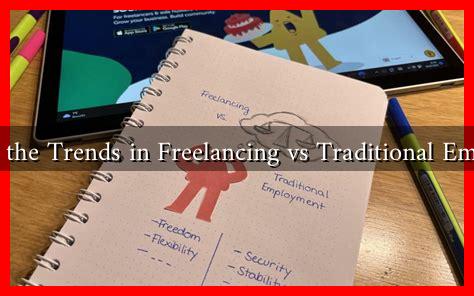-
Table of Contents
- What Are the Trends in Freelancing vs Traditional Employment
- The Rise of Freelancing
- Key Drivers of Freelancing Growth
- Challenges of Freelancing
- Common Challenges Faced by Freelancers
- The Stability of Traditional Employment
- Advantages of Traditional Employment
- Emerging Trends in the Workforce
- Conclusion
What Are the Trends in Freelancing vs Traditional Employment
In recent years, the landscape of work has undergone a significant transformation, with freelancing emerging as a viable alternative to traditional employment. This shift has been driven by technological advancements, changing workforce demographics, and evolving employee expectations. In this article, we will explore the current trends in freelancing compared to traditional employment, highlighting the advantages and challenges of each model.
The Rise of Freelancing
Freelancing has gained immense popularity, with millions of individuals opting for this flexible work arrangement. According to a report by Upwork, as of 2021, 36% of the U.S. workforce was freelancing, a figure that has been steadily increasing over the past decade. This trend is not limited to the United States; globally, freelancing is becoming a preferred choice for many professionals.
Key Drivers of Freelancing Growth
- Technological Advancements: The rise of digital platforms has made it easier for freelancers to connect with clients. Websites like Upwork, Fiverr, and Freelancer.com have created marketplaces where freelancers can showcase their skills and find work.
- Work-Life Balance: Many individuals are seeking greater flexibility in their work schedules. Freelancing allows for a better work-life balance, enabling professionals to choose when and where they work.
- Diverse Opportunities: Freelancers can work on a variety of projects across different industries, which can lead to a more fulfilling career. This diversity is appealing to many who wish to avoid the monotony of traditional jobs.
Challenges of Freelancing
While freelancing offers numerous benefits, it is not without its challenges. Freelancers often face issues such as income instability, lack of benefits, and the need for self-discipline. According to a survey by Freelancers Union, 63% of freelancers reported that they struggle with inconsistent income.
Common Challenges Faced by Freelancers
- Income Instability: Unlike traditional employees who receive a steady paycheck, freelancers often experience fluctuations in income, making financial planning difficult.
- Absence of Benefits: Freelancers typically do not receive health insurance, retirement plans, or paid leave, which can lead to financial insecurity.
- Self-Management: Freelancers must manage their own time, marketing, and client relationships, which can be overwhelming for some.
The Stability of Traditional Employment
On the other hand, traditional employment continues to be a popular choice for many individuals. The stability and benefits associated with full-time jobs are significant factors that attract workers to this model. According to the Bureau of Labor Statistics, as of 2022, the unemployment rate in the U.S. was around 3.8%, indicating a strong job market for traditional employment.
Advantages of Traditional Employment
- Job Security: Traditional employment often provides a sense of job security, with regular paychecks and the potential for career advancement.
- Employee Benefits: Full-time employees typically receive benefits such as health insurance, retirement plans, and paid time off, which can enhance their overall quality of life.
- Structured Environment: Many individuals thrive in structured environments where they have clear expectations and support from colleagues and management.
Emerging Trends in the Workforce
As the workforce continues to evolve, several trends are emerging that blur the lines between freelancing and traditional employment. These include:
- Hybrid Work Models: Many companies are adopting hybrid work models that allow employees to work both remotely and in-office, providing flexibility similar to freelancing.
- Gig Economy Growth: The gig economy is expanding, with more companies hiring freelancers for short-term projects, leading to a more fluid workforce.
- Focus on Employee Well-being: Employers are increasingly prioritizing employee well-being, offering flexible schedules and mental health resources to attract and retain talent.
Conclusion
The trends in freelancing versus traditional employment reflect a significant shift in how work is perceived and executed. While freelancing offers flexibility and diverse opportunities, it also comes with challenges such as income instability and lack of benefits. Conversely, traditional employment provides stability and security but may lack the flexibility that many modern workers desire. As the workforce continues to evolve, it is essential for individuals to assess their personal and professional goals to determine which work model aligns best with their needs. Ultimately, the future of work may lie in a hybrid approach that combines the best elements of both freelancing and traditional employment.
For more insights on the future of work, you can visit Forbes.


